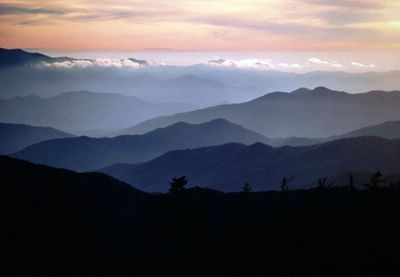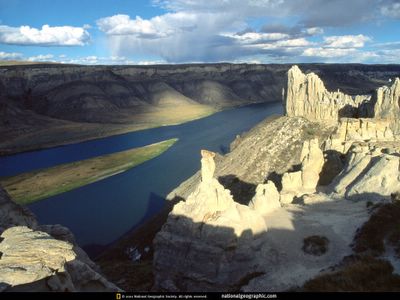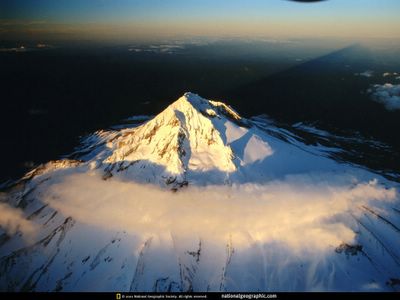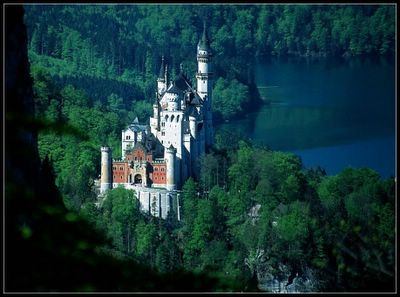Pictures & More
Tuesday, September 27, 2005
Friday, September 23, 2005
Mt. Rushmore

Mt. Rushmore, Black Hills, SD, May 2003
I clicked four pictures of Mt Rushmore on a bright and sunny day in May 2003. I later spliced them together to create a panoramic picture. I was lucky to have a jet flying overhead leaving smoke trails in the sky making it look like the jet had touched Thomas Jefferson's head.
The original dimensions are 2700 x 900 pixels. Blogger limits the picture size. Cant make it big :(
Wednesday, September 21, 2005
The Eye of God?

Helix Nebula NGC 7293
The Helix nebula (New General Catalog number 7293) is estimated to be a mere 450 light-years from the Sun, in the direction of the constellation Aquarius. At that distance it may well be the closest planetary nebula, offering a dramatic snapshot of a brief final evolutionary stage in the life of a solar-type star. In this color image the nebula glows red in the light of nitrogen and hydrogen atoms energized by the ultraviolet radiation from the central star. The main rings themselves, though faint, have an angular size about half that of the full moon and span about 1.5 light-years. Because it is so close, it is a prime subject for study by astronomers. When the Hubble Space Telescope was focused near the inner edge of the main ring, at about the 12 o'clock position in the above image, it resolved some of the spoke like radial structures visible into intriguing cometary knots.
Great Smoky Mountains, Tennessee

Great Smoky Mountains, Tennessee
The Cherokee people called this area Shacomage, or "Place of Blue Smoke." The bluish mist, which clings to the mountainsides and fills the valleys, gives the park its name and remains its most distinctive feature.
Ridge upon ridge of endless forest straddles the border between North Carolina and Tennessee in Great Smoky Mountains National Park, one of the largest protected areas in the Eastern United States.
Monday, September 19, 2005
Taj Mahal

Taj Mahal, Agra, India
Agra was once the capital of the Mughal Empire during the 16th and early 18th centuries. Tourists from all over the world visit Agra not to see the ruins of the red sandstone fortress built by the Mughal emperors but to make a pilgrimage to Taj Mahal, India’s most famous architectural wonder, in a land where magnificent temples and edificies abound to remind visitors about the rich civilization of a country that is slowly but surely lifting itself into an industrialized society.
The postcard picture of Taj Mahal does not adequately convey the legend, the poetry and the romance that shroud what Rabindranath Tagore calls "a teardrop on the cheek of time". Taj Mahal means "Crown Palace" and is in fact the most well preserved and architecturally beautiful tomb in the world. It is best described by the English poet, Sir Edwin Arnold, as "Not a piece of architecture, as other buildings are, but the proud passions of an emperor’s love wrought in living stones." It is a celebration of woman built in marble and that’s the way to appreciate it.
Taj Mahal stands on the bank of River Yamuna, which otherwise serves as a wide moat defending the Great Red Fort of Agra, the center of the Mughal emperors until they moved their capital to Delhi in 1637. It was built by the fifth Mughal emperor, Shah Jahan in 1631 in memory of his second wife, Mumtaz Mahal, a Persian princess. She died while accompanying her husband in Burhanpur in a campaign to crush a rebellion after giving birth to their 14th child. The death so crushed the emperor that all his hair and beard were said to have grown snow white in a few months.
When Mumtaz Mahal was still alive, she extracted four promises from the emperor: first, that he build the Taj; second, that he should marry again; third, that he be kind to their children; and fourth, that he visit the tomb on her death anniversary. He kept the first and second promises. Construction began in 1631 and was completed in 22 years. Twenty thousand people were deployed to work on it. The material was brought in from all over India and central Asia and it took a fleet of 1000 elephants to transport it to the site. It was designed by the Iranian architect Ustad Isa and it is best appreciated when the architecture and its adornments are linked to the passion that inspired it. It is a "symbol of eternal love".
The Taj rises on a high red sandstone base topped by a huge white marble terrace on which rests the famous dome flanked by four tapering minarets. Within the dome lies the jewel-inlaid cenotaph of the queen. So exquisite is the workmanship that the Taj has been described as "having been designed by giants and finished by jewellers". The only asymmetrical object in the Taj is the casket of the emperor which was built beside the queen’s as an afterthought. The emperor was deposed by his son, Aurangzeb, and imprisoned in the Great Red Fort for eight years but was buried in the Taj. During his imprisonment, he had a view of the Taj.
The dome is made of white marble, but the tomb is set against the plain across the river and it is this background that works its magic of colours that, through their reflection, change the view of the Taj. The colours change at different hours of the day and during different seasons. Like a jewel, the Taj sparkles in moonlight when the semi-precious stones inlaid into the white marble on the main mausoleum catch the glow of the moon. The Taj is pinkish in the morning, milky white in the evening and golden when the moon shines. These changes, they say, depict the different moods of woman.
Different people have different views of the Taj but it would be enough to say that the Taj has a life of its own that leaps out of marble. As an architectural masterpiece, nothing could be added or subtracted from it. It is faultless.
Sunday, September 18, 2005
Neuchwanstein Castle

Neuchwanstein Castle
(The castle is in the background... up in the mountains)
"Eulogy in stone to a musical genius, Neuchwanstein Castle beckons from its Alpine setting far behind a country church near Füssen. Bavaria's King Ludwig II was so taken with Richard Wagner's operas that he built this castle expressly to capture the spirit of their soaring romantic strains."
—From "West Germany: Continuing Miracle," August 1977, National Geographic magazine
Saturday, September 17, 2005
Plate full of Strawberrries

Luscious Strawberries
This picture was taken Dec 2004 at Mahabaleshwar, (Maharashtra, India), a hill station famous for its jams, jellies, honey and of course strawberries. These strawberries were the best that I have ever eaten. Perfect texture and sweet as nectar. How I wish I could just pick one up from the picture and pop it in my mouth :-)
Tuesday, September 13, 2005
Cliffs overlooking Lake Superior

The weather beaten cliffs of Palisades, Lake Superior, Duluth, MN
Palisades, quite popular with rock climbers is also my favorite spot in Duluth. 400 feet of sheer rock braving the icy cold winds blowing over Lake Superior. In the middle of May 2004, when I took this picture, the temperature was a balmy 25 Farenheit. The cliffs were keeping a lone vigil over the lake. There were no rock climbers, kayakers or picnickers to disturb the serenity.
The Awesome Royal Bengal Tiger

This one is from National Geographic. Photographed in Bandhavgarh National park in Umaria district, Madhya Pradesh, India.
Best Time to Visit - Bandavgarh National Park
The visiting season of Bandhavgarh national park starts from Mid-November to June, as the park remains closed during the monsoon months from July to early November.
How to Get there
Air : Khajurao at 230-kms is the most convenient airport connected by various domestic airline services with Agra, Delhi, Varanasi.
Rail : The nearest railhead Umaria at 30-kms is on the Katni-Bilaspur section of South-Eastern Railway. Another convenient railhead Satna (117-kms) is on the Bombay-Howrah main line of the Central Railway.
Road : Bandhavgarh National Park is situated on the Satna-Umaria & Rewa-Umaria highway. Some of the important road distances are: Khajuraho (via Satna)230-kms, Varanasi (via Rewa) 340-kms, Katni 75-kms, Rewa 115-kms, Umaria 30-kms, Kanha 250-kms. Madhya Pradesh State Transport Bus Services are also available from Rewa, Satna, Katni and Umaria.
-----
The natural heritage in India is as rich and diverse as the cultural heritage. The wildlife sanctuaries and the national parks here give you an essence of the same. Nestled in this rich land is the Royal Bengal Tiger, the only home to the Royal Tiger Cat. The largest living member of the cat family has a rather graceful built and gait. Bengal Tiger is the fastest running animal. Its length can measure up to 10 feet and has a weight ranging from 180 to 260 kgs.
The habitat of this elegant swift mammal (Bengal Tiger) varies from the swamps of the Sunderbans to the desert land at Ranthambore, from the foothills of Himalayas at Corbett National Park to Bandipur in the peninsular India. In 1973 was launched the Project Tiger to get hold of the dwindling count of the indian tigers. Around 9 wildlife sanctuaries were declared as tiger reserves, which has now increases to 19 covering an area of 33,000 sq. kms in 14 states. The beauty of the royal bengal cat can now be seen in its natural surroundings in these conserved areas.
If you are fascinated by the royal Bengal tiger and wish to see it in its natural surroundings, a visit to these tiger reserves is bound to be an enchanting one. All these reserves have the facility of tours to the forested area to watch Bengal Tiger. One can choose a suitable mode to tour. It can be by jeep or on the elephant backs. Corbett National Park was the first one covered under the Project Tiger. Named after the famous environmentalist Jim Corbett, it houses diverse flora and fauna and has weather suited for flourishing wildlife.






















